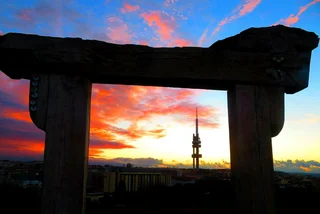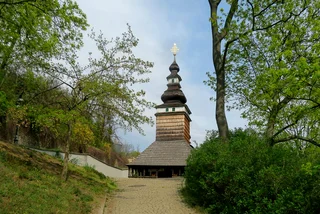The Czech Republic has quite a few spooky old buildings that have fallen into ruins. One has become known internationally as the “ghost church,” and its fame has helped put it on road to restoration. After half a century of neglect, the roof is repaired, the entire facade is almost completely renovated, and work on the interior is about to begin.
Repairs to the Church of St. George (Kostel svatého Jiří) in the small village of Luková in the Plzeň region have been taking place now for seven years so far and have cost over CZK 8.3 million.
PARTNER ARTICLE
The turnaround in the collapsing building’s fate began in 2012 when art student Jakub Hadrava put sculptures of ghostly shrouds seated in the pews of the Church of St. George (Kostel svatého Jiří) in the small town of Luková in the northern Plzeň region. The project was his bachelor’s thesis and officially has the title “My Mind” (Má mysl).
The 32 sculptures were made out of canvas and curtains dipped in plaster, and modeled from real people. They are meant to represent the people who used to attend the church, the long-vanished congregation. Hadrava also said he wanted to explore the connection of sculptures and where they are located, the places where they “come to life.”
Information about the exhibition quickly spread, and starting in 2013, tourists from all over the world began to visit the church to take pictures of themselves sitting among the shrouds. The number of visits rose from 712 in 2013 to 15,600 in 2020 but saw a slight drop in 2021.
What was meant as a temporary exhibit has become permanent. The church is now open to tourists from May to October only on Saturdays from 1 pm to 4 pm. The monument will also open on June 10 for the Night of the Churches (Noc kostelů).
“Some 500 to 800 people come on a single Saturday,” Manětín Mayor Josef Gilbert said. Manětín is the closest town, and Luková falls under its control.

A short time after the art project began to attract people, the church was included in the Ministry of Culture’s program for the preservation of architectural heritage. The ministry contributes the majority of the money spent on repairs, but support from the public has also significantly contributed to the ongoing work. You can find out how to contribute, and see the list of sponsors on the church’s website.
The thousands of visitors over the past decade have left over CZK 1.5 million in the coffers in voluntary donations. Additional money has been donated by sponsors and donors, and a music festival was held to support the monument. This money is used by the Manětín parish to co-finance repairs.
The ministry's first contribution went to the church in 2015 and was used to ensure the structural security of the building, and repair the vault and the roof of the presbytery and the roof of the sacristy.
In the following years, the roof was repaired, the building was drained, and all the windows were refurbished or restored. The church received a new entrance door under the tower, and the exterior plaster and facade were gradually repaired.

"The plan for this year is to complete the last part of the exterior facade, then gradually begin the restoration of the interior of the church," Mayor Matuška said.
Before the exhibition started, the church had been closed since 1968, when the roof collapsed during a funeral. It was just the last in a long line of tragedies for the church.
The original structure was built in 1352, but damaged soon after in the Hussite wars. Then there was a fire in 1786. The church was rebuilt in 1854–58 in the neo-Romanesque and neo-Gothic styles. It carried on with services for a little over a century, but without investment into upkeep, it began to deteriorate.
The village of Luková used to have over 100 inhabitants, and in the middle of the 19th century, when the last major rebuilding took place, there were 500 people in the church parish.

The area, part of the Sudetenland, had a mixed German and Czech population, and when Germans were forced to leave after World War II the village never recovered. Now, the village has just five residents plus a few people who use cottages on weekends. The collapsed roof from 1968 was not repaired, due to a lack of funds, and the church fell further and further into ruin over the next 45 years.
Not surprisingly considering the rundown state of the building, stories began to spread that the place was cursed or haunted. This has now become part of the allure of visiting the ghost (sculpture)-filled church.
This building isn’t to be confused with the so-called Bone Church in Kutná Hora, Central Bohemia, which is also undergoing restoration.












 Reading time: 4 minutes
Reading time: 4 minutes 



























